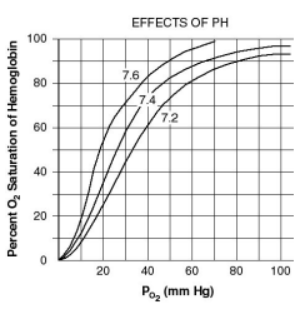The graph below shows an oxygen dissociation curve, with the normal curve in the center. What is the name of the phenomenon that shifts the curve to the right? What causes this change in oxygen dissociation? Is the shift beneficial or detrimental? Explain.

The shift in the dissociation curve is called the Bohr effect. The decrease in pH may be due to an increase in CO2 and lactic acid during vigorous physical activity, or to metabolic acidosis. The Bohr effect is beneficial, because the unloading of oxygen from hemoglobin increases under such conditions. If the decrease in pH is due to exercise, then the skeletal muscles have an increased demand for oxygen, and thus increased unloading is desirable.
You might also like to view...
The root "chroma" means
A. body. B. strength. C. condition. D. color. E. characteristic.
The occipital bone has a large opening called the ____ through which the spinal cord connects to the brain.?
a. mental foramen b. occipital condyle c. foramen magnum d. temporal condyle
The contraction phase of a muscle twitch has a shorter duration than the relaxation phase
Indicate whether this statement is true or false.
What is the structural classification of interneurons?
A. Unipolar B. Multipolar C. Bipolar